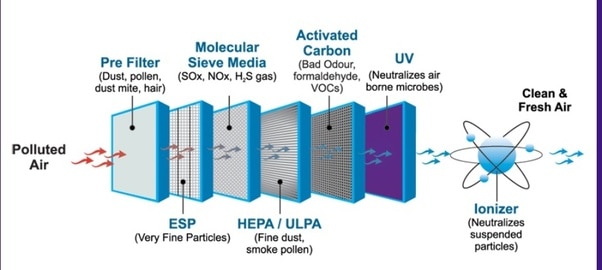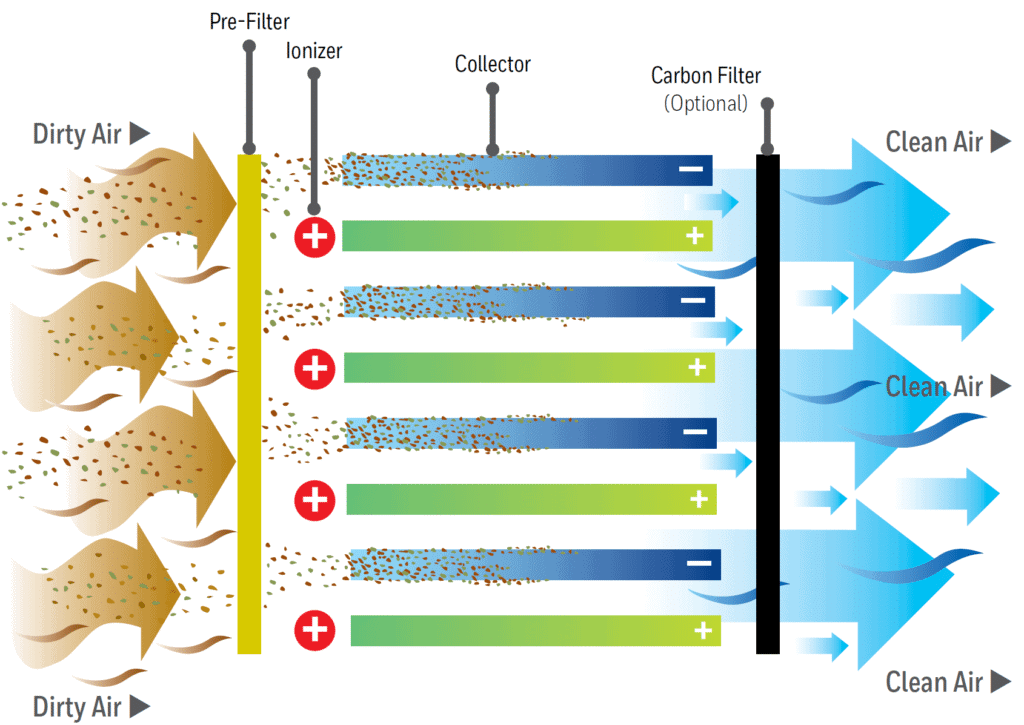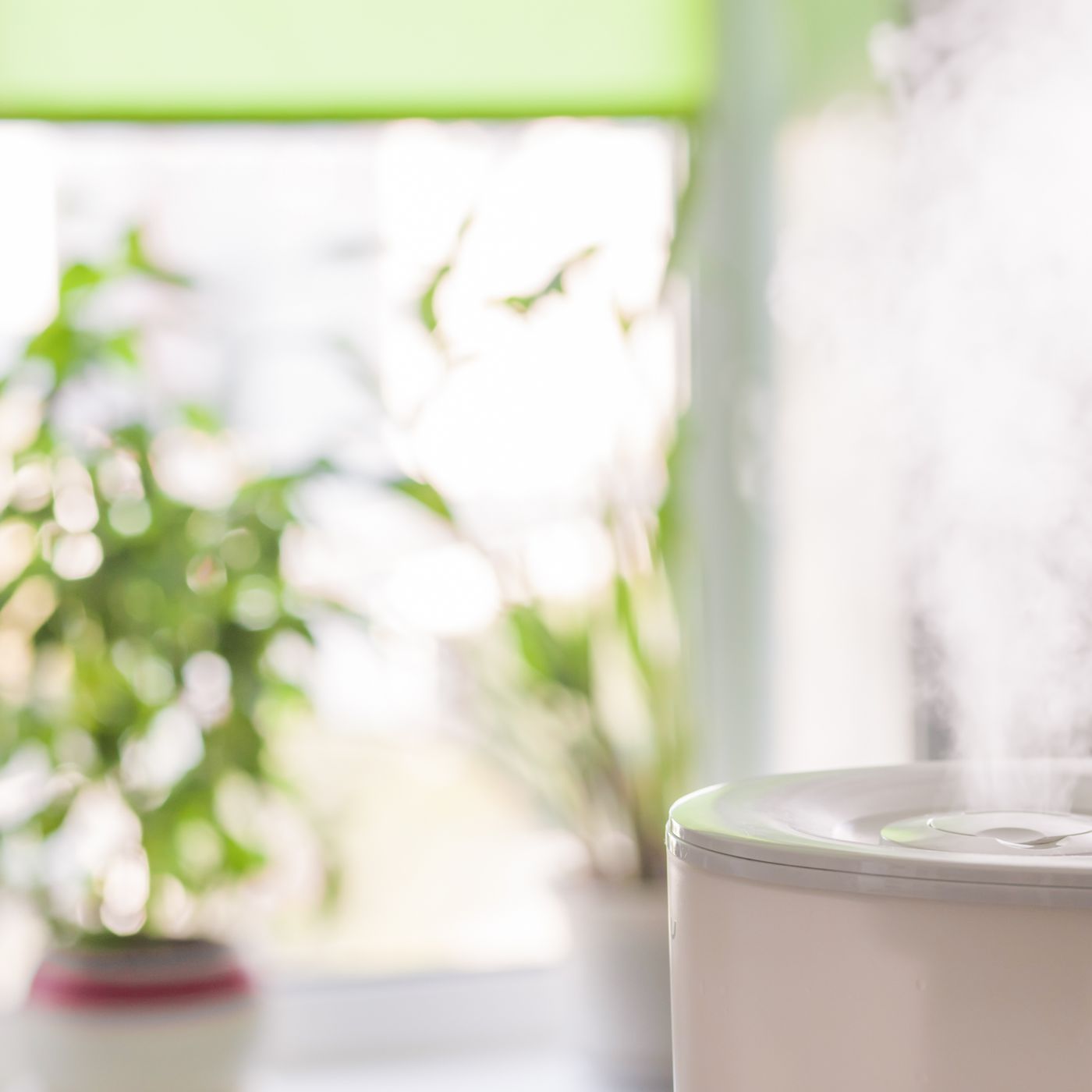Many doctors nowadays cite poor indoor air quality as one of the main causes of respiratory problems and allergies. The reason behind this is very simple. Our daily environment contains a multitude of fume-releasing chemicals, while new and more powerful viruses and bacteria constitute a growing threat.
However, you can protect your family with the help of a high-quality air purifier that helps rid your home of these pollutants, germs, and irritants.
Our extensive search has found the Alen BreatheSmart Classic Air Purifier with HEPA-Pure Filter to be one of the best air purifiers available on the market.

Photo credit: quora.com
How Do Air Purifiers Work?
Despite all of them serving the same function, different air purifiers have different ways of functioning. For example, an ionizer air purifier works distinctly from an ozone air purifier. Below is a detailed description of how each air purification system works to improve indoor air quality.
An air purifier is the best solution for homes whose residents are sensitive to various allergens.
Allergens such as pollen, bacteria, smoke, pet dander, mold spores, viruses, and other pollutants cause damage to your lungs and immune system. Unfortunately, most of these irritants are not visible to the naked eye. This is where air purifiers come in. They filter pollutants and allergens that are seen and unseen by the human eye with the help of filter, ozone, or electrical attraction.



Photo credit: achooallergy.com
Air filters use fine sieves that filter particles from the air circulating around us. These sieves are typically made of fiber, mesh, or paper, and require regular replacement to ensure that they keep working efficiently. As the air flows into the air purifier, the sieve inside traps the small particles and pushes the clean air outside, back into the living space. This process repeats itself many times in an hour, thus keeping your environment healthy. The finer the sieve, the more minute particles it can trap.
The accepted standard for air filters has been set by the High-Efficiency Particulate Air (HEPA) filters. These filters are guaranteed to trap 99.97% of airborne particulars that are bigger than 0.3 microns. Microns refer to the standard unit used to measure air particles. Each micron is equal to 1/25,400th of an inch.
It is not possible for the naked eye to see anything smaller than ten microns; therefore, pollutants such as viruses and bacteria escape detection. Room air conditioners filters are only able to capture particles that range up to ten microns or more.
Meanwhile, HEPA filters are designed to remove smaller allergens such as pollen, pet dander, dust, smoke, asbestos, and chemicals. It is the room capacity of a HEPA air purifier that determines whether the product is suitable for your needs.
How Does an Ionizer Air Purifier Work?
Ionizer air purifiers, also known as air ionizers, work on the principle of the ionization of molecules. They emit negatively charged ions into the air to capture dander, pollen, dust, and any other form of air pollution. This is possible because an airborne particle mainly contains a positive charge.
These particles then form a bond between them, which makes them a little heavier than usual. As a result, they fall to the ground and/or become trapped on an electrostatic collection plate. Unlike other purifiers that require filter changes, ionizers may only need the cleaning of the ionizer plate, which is way more cost-effective.



Photo credit: theairgeeks.com
How Do Ozone Air Purifiers Work?
While traditional filters keep out airborne pollutants, different kinds of allergen, and other particulate matter, ozone air purifiers use high-voltage electrical currents that convert oxygen to ozone. Ozone is a powerful oxidant that breaks down molecules and microorganisms in the air. This type of purifier is mainly used to eliminate bad odors rather than remove allergens and particles from the air.
Hence, if you're going to use an ozone air purifier, it'd be best to pair it up with another purifier that will filter out particles. It's also worth noting that ozone can have harmful effects on the body, so it's not ideal for domestic use.
How Does a Water Air Purifier Work?
Water air purifiers are some of the most affordable purifiers on the market. You'll save a fortune with these devices. However, they aren't half as effective in cleaning the air and trapping particles as other purifiers. They work by shooting your home's dirty air into a water basin. That makes all the contents of the air wet, rendering them immobile. Once the air has been filtered by the water in your air cleaner, it'll usually then be further processed by your machine.
How Does a Fanless Air Purifier Work?
Fanless air purifiers are also relatively budget-friendly. However, they have to be placed where air passes through the room since they don't have a fan to draw in the air inside the house. These types of purifiers aren't effective when eliminating foul odors and only work to trap dust, pet dander, pollen, and other particles.
How Do Electrostatic Air Purifiers Work?
These purifiers usually work by drawing in particles with a fan and charging them using a series of high-voltage wires. They have several plates, also called precipitating cells, that carry the opposite electrical charge. Since opposite charges attract, the particles are attracted by the plates as they pass through that section.
These types of purifiers have an efficiency of about 95%, so they can't be fully relied on. Additionally, the electrostatic plates will need to be replaced over time. This kind of purifier can also produce ozone when it's used frequently.



Photo credit: simplythebestac.com
Benefits of Investing in a Great Air Purifier
Inhaling harmful pollutants can be the root cause of various minor to severe health conditions which not only cause a decent amount of suffering and can also cost a lot of money in doctors’ fees and medication. Therefore, investing in a high-quality air purifier is one of the most sensible choices you can make for the overall health of your whole family. Its various benefits can be summarized below:
Removes Common Air Pollutants
There are various common pollutants found in the air inside your home including dust mite allergens, plant spores, mold, fungi, dander from pet hair, and pollen. Air purifiers trap these pollutants, thus ensuring a healthier home environment. Since a number of these pollutants can cause allergic reactions and respiratory problems, an air purifier can help improve your family’s health, especially in children and the elderly, who may already suffer from health problems.
Helps Remove Insects
Another great benefit of air purifiers is that it is able to remove dangerous insects such as mosquitoes from the atmosphere, keeping you safe from nasty mosquito bites and the potential infection that can happen as a result of these bites.



Invaluable for Asthma Patients
Asthma is often caused by breathing polluted air. In order to prevent the onset of asthma, it is better to take precautions to breathe clean and fresh air. Moreover, if somebody already suffers from asthma, using an air purifier can help reduce the number of asthma attacks and their intensity by ensuring that there are no pollutants present in the air that could trigger an attack.
Reduces Airborne Germs
Some air purifiers have a germicidal filter that helps get rid of viruses and bacteria that can cause diseases. This is great for the health of your family because if one person is suffering from a cold or flu, using an air purifier will safeguard the other members of your family from contracting the same virus. Even if your air purifier does not contain specific antibacterial properties, it will still stop the germs from reproducing by trapping the fine particles.
Types of Air Purifier Filters
Air purifiers come in various sizes, shapes, and colors and they do not all work the same. Different air purifiers utilize different technologies to clean the air that we breathe. The most common types of these air purifiers are:
HEPA Technology
HEPA or High-Efficiency Particle Air filters help trap 99.97% of all particles larger than 0.3 microns. These particles include chemicals, viruses, and bacteria which are not visible to the naked eye. HEPA filters help create a more sanitary environment and do not generate ozone or any other harmful byproducts. Although HEPA filters are effective in trapping airborne particles, they do not remove gases or odors. Therefore, HEPA air purifiers are designed with activated carbon-based material to absorb chemicals and odors not caught by HEPA filters.



Photo credit: comfyhomecorner.com
Activated Carbon Technology
Activated carbon filters are designed with many molecule-sized pores that have high chemical bonding and absorbent ability. These filters are highly effective in capturing pollutants such as tobacco smoke, chemical emissions, gases, and odors. These filters are usually recommended for people with Multiple Chemical Sensitivity (MCS) as they absorb formaldehyde which is present in wood paneling, carpets, and furniture upholstery. These filters remove chemicals found in household cleaning items and perfumes, making the air more breathable especially for babies, the elderly, and asthma patients.
UV Technology
UV technology is used primarily in conjunction with particulate filter systems because it does not get rid of airborne particles. However, they are highly effective in killing viruses and bacteria. Air purifiers that use this technology are designed with a UV lamp. When the microorganisms pass by the UV rays of the lamp, genetic or cellular damage occurs which destroys the microorganism.
Our Favorite Air Purifier:
Alen BreatheSmart Air Purifier with HEPA-Pure Filter

PROS
CONS
One of the most powerful and highest coverage purifiers, combined with SmartSensor and WhisperMax technology has made the Alen BreatheSmart Classic air purifier the preferred model by consumers when choosing a highly capable air purifier.
The Alen BreatheSmart has a clean air delivery rate (CADR) of 300 CFM, ensuring fresh and pure breathable air in every corner of your home. Perfect for living rooms, open concept rooms, and any other areas with an area of up to 1,100 square feet, this air purifier quietly and efficiently removes harmful allergens and dust in less than two hours.
Designed along crisp style lines and fitted with smart sensors, the Alen BreatheSmart classic air purifier comes with a lifetime warranty thus ensuring years of comfort for their consumers. This air purifier uses WhisperMax technology that allows this purifier to run without making much noise.
The smart sensors in this air purifier allow you to detect the level of pollution in your home. The air quality indicator then displays these findings. Moreover, these smart sensors also control the air purifier’s auto mode. The speed of the fans is adjusted automatically, depending on the required level of purification.
Another innovative mode that sets this air purifier apart from other purifiers is the sleep mode which minimizes noise and turns off the LED indicators to keep the room quiet and dark. In addition, this air purifier has several child-friendly features. You can lock the control panel and prevent children from changing the purifier’s settings unintentionally. Moreover, the air-vents are also designed with child safety in mind.
Another great feature of the Alen BreatheSmart is that its front panel is highly customizable. There are 14 different panel designs and colors available, thus giving you a wide range of choices. You can pick one that matches your room or you can also buy additional colors if you want a different look in the future. The available color and designs include Classic Red, White, Espresso, Luxury Marble, Vintage Gold, Brushed Bronze, Graphite, Oak, Maple, Redwood, Vintage Silver, Weathered Grey, Brushed Stainless, and Safari Black.
This air purifier also has an ionizer which is ozone-free. It produces negative ions that bring the particles together, making it easier for the HEPA filter to trap the molecules. Moreover, this unit is highly energy efficient using only 105 watts when running on turbo setting. The built-in timer is an additional feature that increases user convenience.
The top panel of this product holds the electronic control button, making it easier for users to change the settings on this air purifier. The air intake grills are both on the sides and bottom of the panel while the output grill is located at the back. Therefore, it is important to ensure that there is ample space between the wall and the machine to maximize air circulation.
Bottom Line
One of the highly efficient and reliable air purifiers available today, the Alen BreatheSmart classic air purifier has various convenient features that make it the top choice of users. These features include adjustable speed, an auto mode, air-quality indicator, customizable panel color, lifetime warranty, and a timer. With its wide purifying coverage and excellent airflow performance, this air purifier is able to provide you with unlimited amounts of clean and fresh air.
Conclusion
Breathing fresh air can bring a big difference in your life. It not only benefits children, older people, and people who suffer from chronic illness, but it is also important for everyone as it can refresh your body and mind. With the Alen BreatheSmart classic air purifier with HEPA pure filter, you can make sure the air of your home is free from germs, pollutants, allergens, and other harmful particles, thus allowing you to lead a stress-free, healthy, and happy life.



Photo Credit: ThisOldHouse.com
People Also Ask
For those who may still have some concerns regarding air purifiers, here are our answers to some of the most popular questions.
How Well Do Air Purifiers Work?
This depends on the type of purifier you use. Some purifiers, particularly those with a HEPA filter, can remove up to 99.97% of particles floating in the air. Others, on the other hand, merely eliminate odors.
How Long Does It Take for an Air Purifier to Work?
Air purifiers don't offer a quick solution. It takes a while for you to start noticing the improvements in your indoor air quality. Depending on the purifier you use, the size of your house, and its location, it can take between four-to-six weeks.
